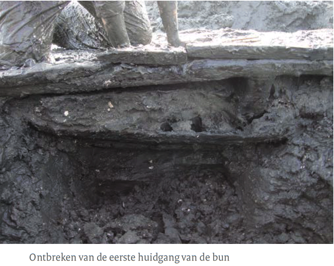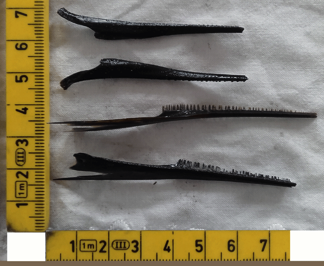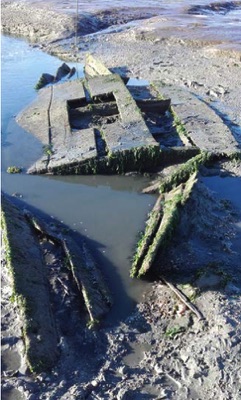
Wreckage Westerveld 2
How it started
In 2013, a wooden shipwreck was found by Michael Horn, a resident of Vlieland, on the mudflats south of the village of Oost-Vlieland.
He has reported this wreck to the Cultural Heritage Agency (RCE). Based on the information sent and because of the acute threat to the site, archaeologists from the Maritime Program decided to conduct an appreciative field investigation.
This appreciative research, carried out in 2014, revealed the remains of a relatively small, well-preserved bunship from the mid-sixteenth century.
The ship
This clinker-built ship has been given the toponym Vlieland Westerveld 2 by the RCE and has many characteristics of the water ship type.
These types of clinker vessels are considered to be the oldest type of water ship. The ship found here was also clinker-built and is in the middle of the period in which a slow transition took place from clinker-built to carvel-built ships.
What makes this wreck truly exceptional is that it is much smaller than all other water vessels. The smaller size, the slender construction, the two compartiment fishwell and the finds made could indicate that this ship was intended for fishing and possibly the transport of fish to the urban market. This distinguishes it from the better-known fishing vessels.
The upper part of the wreck, from the top of the fishwell, has disappeared. The remains are intact and reasonably coherent.
Finds
During the field investigation, parts of the bow, a timber, part of strake G4/Port side and various fragments of coniferous wood were found.
In addition to the peat blocks, tiles were also found in the bow, possibly from a fireplace. So it seems that the ship was equipped with a place where a fire could be lit. It is quite conceivable that turfs were part of the standard equipment. These enabled the crew to start a fire to prepare a meal, for example.
In total, peat, some tiles, pottery, brick, natural stone, leather, a rope fragment, a block (wooden pulley), fragments of a barrel stave and a hoop, a cylindrical object made of wood, a tool handle, a handle, an object made of beech wood with a hole, a heath scrubber (brush made from heather bushes), nails and a grinding stone were found in the wreck. Later, several fishing hooks and a boat hook could be added.
Samples were collected from ship itself and from inside the ship, including a repair board, caulks, a possible peat patch and various loose samples.
These samples were examined by BIAX, a company specialized in archaeobotany and paleobotany. This was made possible thanks to a subsidy from the Reuvens Fund.
The ship is caulked with mosses, mainly sickle moss. It probably concerns Knieff’s hook-moss, a common species that also occurs on Vlieland. The ship was repaired at a later stage. An oak plank was used for this, from which the ship is also made. The caulk under the nail from this recovery phase has the same composition as the "original" caulk, which could indicate that the boat has been restored in the area where it was built.
The peaty blocks found in the vicinity of the floor tiles in the forepart of the ship appear to be indeed peat sods based on the presence of typical raised bog plants, including Hare's-tail cottongrass, Heather, Cross-leaved heath, Sphagnum moss and Northern deergrass. They probably served as fuel for the crew.
In the loose samples collected in the bunscheepje, various edible crops were found, including fruit (apple, grape, elderberry, wild plum (Blauwe spilling) and fig), nuts (hazelnut, walnut, sweet chestnut) and oilseeds (flax seed and turnip seed). These remains probably formed part of the crew's food supply.
Remains from fishwell in the wreckage have also been examined. The fish bones were identified using the comparison collection of the Cultural Heritage Agency.
A total of 548 fish bones were analyzed.
Based on numbers, preservation and distribution among the skeletal elements, we can conclude that during the sinking of the ship the bun was filled with at least 10 plaice and 4 garfish. The remaining fish remains may have been washed in with sand during later washing. Nineteen garfish bones are included in the RCE comparison collection.
And further.......?
The results of the research give the ship an average to high rating for its substantive and physical quality, meaning that the wreck can be qualified as worthy of preservation. However, due to natural disturbances and human activities, the wreck cannot be preserved in situ. In particular, progressive erosion by a stream channel in the immediate vicinity of the site poses a direct threat. The advice is therefore that the municipality takes action to protect the wreck against this erosion or have it excavated.
On October 6, 2023, ten years after the discovery of this very special wreck, a special work of art was unveiled along the Postweg, just outside the urban area of the village, pointing out to visitors the location of the wreck.
The artwork was made by Maarten Nijman, poet in steel, and was made possible thanks to support from the Cultural Historical Association "Eylandt Flielandt”, the „Iepen Mienskipsfûns“ and the Municipality of Vlieland.
In 2025, an exhibition about this wreck will be held in the Tromp's Huys museum, where the various finds can be admired.
Welcome
You, probably, arrived at this page because you used the QR code that is attached to the artwork that is located near the Wrakje Westerveld 2.
When you sit on the bench and look out over the mudflats, you only see the beacons that Rijkswaterstaat has placed at the corners of the place where the remains of the pink-like ship are located at the bottom of the mudflats.
Here you can take note of a unique wreck from the 16th century.






Jawbone of the garfish (Belone belone)

Clinker-built hull

Model based on findings

Boat hook from the fishwell of the ship

Wreckage, in situ September 2016
Upper part of the fishwell is missing
Survey of the bottom around the wreck with a probing stick